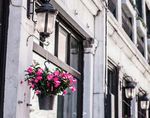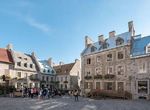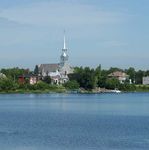COMPANION PROGRAMME SCHEDULE OF ACTIVITIES
←
→
Page content transcription
If your browser does not render page correctly, please read the page content below
COMPANION
PROGRAMME
SCHEDULE OF ACTIVITIES
The ICPA Companion Programme
began in Perth, Australia. Since then, it PROGRAMME OVERVIEW:
has been offered at every ICPA Annual
Conference. The Programme allows SUNDAY 21 OCTOBER 2018
spouses, friends, and significant others to Conference Welcome Reception
learn and to explore the unique cultural
and scenic wonders that each conference
venue offers...as well as to meet other MONDAY 22 OCTOBER 2018
Companions. Meet & Greet
This year’s Companion Programme Host Welcome Reception
has been carefully designed to allow
participants an opportunity to experience
the exciting places of Montréal. DAY 1 - TUESDAY 23 OCTOBER 2018
City Tour of Montréal
ICPA will be running its Companion - Walking tour of the Old Montréal
Programme in parallel with the main event. - Notre-Dame Basilica
Treat your spouse or a family member by - Lunch
registering them to take part in three fun- - Bus tour of Montréal
filled days of exploring the dynamic city of
Montréal and it’s surroundings. Duration: 9:30am to 4:30pm
DAY 2 - WEDNESDAY 24 OCTOBER 2018
Space in the Companion Program is limited
to 45 Participants. Interested attendees are The Richelieu Valley
encouraged to register as early as possible. - Cider mill and product tasting
- Lunch in the village of Chambly
Duration: 10:00am to 4:00pm
ICPA Correctional Excellence Awards
Ceremony & Gala Dinner
DAY 3 - THURSDAY 26 OCTOBER 2017
A Day in Québec City
COST: $ 395 USD - Plains of Abraham
PER PERSON - Notre-Dame Church
- Place-Royale
- National Assembly
- The Citadelle
- The famous Château Frontenac
- Lunch in a local restaurant
Duration: 8:00am to 8:00pmDAY 1: Tuesday - 23 October 2018
City Tour of Montréal
Your adventure will start with a walking tour of the Old Montréal and a visit to the Notre-Dame Basilica. For lunch, you will taste some
of Montréal’s most iconic foods, such as poutine and smoked meat. Afterwards, you will board your private motorcoach for a bus tour
of Montréal. See city’s elegant upper-class communities, the financial district, cultural institutions, and some of its universities. You
will also explore the Plateau Mont-Royal, known for its distinctive architecture and its Francophile atmosphere as well as the Sainte-
Hélène and Notre-Dame islands, which were home to the 1967 Universal Exposition (Expo ’67). Along the way, the tour includes a
stop at the Mont-Royal for a panoramic view of the city and a tasting of Montréal bagels.
Departure point: Marriott Château Champlain (1050 Rue de la Gauchetière O)
1. Walking tour of the Old Montréal
Situated between the rue St-Antoine and the port and flanked by rue McGill and rue
Berri, Vieux-Montréal (Old Montréal) is the site of Maisonneuve’s original settlement
of Ville-Marie.
The picturesque Place Jacques-Cartier makes a good starting point for visiting the
area. Once a fruit and vegetable market, the cobblestone square remains a favourite
venue for flower vendors and itinerant artists.
Across rue Notre-Dame, the 19th-century Hôtel de Ville (City Hall) is a fine example
of the French Renaissance style. It was from the balcony beneath the clock in
1967 that Général de Gaulle delivered his incendiary cry of ‘Vive le Québec libre!’,
warming the hearts of local separatists. The general was not intimidated by the
statue of Lord Horatio Nelson watching him from the top of Place Jacques-Cartier.
Montréal’s oldest monument was somewhat provocatively erected in 1809, just four
years after the British admiral’s devastating defeat of the French at Trafalgar.
2. A Visit to the Notre-Dame Basilica
Notre-Dame Basilica of Montréal is located at the intersection of Notre-Dame
Street West and Saint-Sulpice Street in the borough of Ville-Marie in Montréal.
This jewel of Québec’s religious heritage was built by the Sulpicians over the years
1824 to 1829, to serve as a parish church. It is one of the oldest examples of Gothic
Revival religious architecture in Canada. At the time it was built, it was a daring,
innovative edifice on a scale unequalled anywhere else in North America. The
architect was James O’Donnell, an Irish immigrant to New York City. Its interior
decor, which was overseen by Victor Bourgeau, along with its rich ornamentation,
are unique and evoke a true sense of wonder in visitors. The Basilica is also one of
the major tourist attractions in the city of Montréal.
3. Bus tour of Montréal
Explore city’s elegant upper-class communities, the financial district, cultural
institutions, and some of its universities
Take some photos from the Plateau Mont-Royal, as well as the Sainte-Hélène
and Notre-Dame islands, which were home to the 1967 Universal Exposition
(Expo ’67).DAY 2: Wednesday - 24 October 2018 The Richelieu Valley The Richelieu Valley, also called the Apple Region offers panoramic scenery coupled with an ideal climate for the gardening of market produce. The Montéregian hills are surrounded by huge orchards and apple industries. During the tour, you will visit a cider mill and taste their products derived from apples as well as a vinegar factory, where they transform the apple cider into apple cider vinegar, which boasts a variety of health benefits. Will follow a delicious meal in the village of Chambly – a special meal made from local products - on the banks of the Richelieu River before heading back to Montréal. Fall in Québec sweeps in with a burst of colour, aroma and flavour. As September draws to a close, the forests don fiery hues as the leaves turn their characteristic reds, yellows and oranges. Vines and orchards are laden with fruit, while clouds of snow geese fill the skies in a spectacular pre-Christmas pageant. With its dry, crisp air and brilliant blue skies, fall is the perfect time for long rambles through the hills. Departure point: Marriott Château Champlain (1050 Rue de la Gauchetière O) 1. The Richelieu Valley - Cider mill and tasting The Richelieu Valley, which attracted pioneers from the start of the 18C with its fertile lands, is nowadays one of the richest agricultural areas in Quebec. It is nourished by the majestic Richelieu River (130km), one of the links in the riverway running from Montreal to New York. Very popular with Montrealers, every summer the valley attracts thousands of travellers and tourists, who, from Chambly, come here to experience the beauty of this area as they stroll along the riverbanks. First settled in the late 15th century by the Iroquois, the terroir of Montérégie is perfectly suited for agriculture, with many mountains, hills and shaded valleys. The soil has developed a perfect balance mixing with the climate it’s an ideal place for hardy trees like apple and maple to prosper. 2. Lunch in the village of Chambly Chambly lies along the Chambly Basin—a widening of the Richelieu River. Its site, 14 miles (23 km) east of Montreal city, was first occupied by Fort-Chambly, a wooden stockade built in 1665 by Captain Jacques de Chambly, a French army officer and leader of the Carignan Regiment. Destroyed by Iroquois Indians in 1702, it was later rebuilt in stone. Surrendered to the British in 1760, the fort played an important part during the American invasion of 1775 and during the War of 1812. The city is now an agricultural market centre of a cash-crop, dairying, and fruit- growing region. A nearby hydroelectric plant supplies power for Chambly and much of Montreal. Among the city’s many historical sites are Fort-Chambly National Historic Park, the monument and home of Colonel de Salaberry (a hero of the War of 1812), and Jacques-de-Chambly Historical Village, a collection of 18th- and 19th-century buildings. Inc. 1951. Enjoy the beautiful views with a special meal made from local products. The lunch will be on the banks of the Richelieu River.
DAY 3: Thursday - 25 October 2018
A Day in Québec City
Classified by UNESCO as a World Heritage Site in 1985, the city of Québec, capital of the province of Québec, is the only remaining
entirely fortified city in North America and dominates the St. Lawrence River. Founded in 1608 by Samuel de Champlain, Québec
was the first permanent European settlement in New-France. The city’s buildings and monuments are models of its rich architectural
history and give Québec its renowned European flair. During the tour, you will see the Plains of Abraham, the Notre-Dame Church,
Place-Royale, the National Assembly, the Citadelle and the famous Château Frontenac. See if you can resist the ambiance of Québec
City! Lunch will be included in a local restaurant.
Departure point: Marriott Château Champlain (1050 Rue de la Gauchetière O)
1. Plains of Abraham & Notre-Dame Church
Plains of Abraham, also called Heights Of Abraham, French Plaines D’abraham, plains
in Québec region, southern Quebec province, Canada. The plains lie at the western
edge of the old walled city, overlooking the St. Lawrence River. The plateau was the
scene of a battle (Sept. 13, 1759) between the French under the Marquis de Montcalm
and the British under James Wolfe in which both leaders were killed but which
secured Quebec for the British. Named for Abraham Martin, a ship’s pilot who formerly
owned part of the land, the plains are now a national historic park.
Notre-Dame Church standing on the same location since 1647 and designated a
Canada National Historic Site given its architectural value, the Cathedral bears witness
to the history of a whole population. Here rest four governors of New France, the
bishops of the diocese of Québec and a funerary chapel dedicated to François de
Laval. Visitors will see various works of art and pieces of archives with the splendid
interior decoration as a background.You could also see de Holy Door.
2. Place-Royale & National Assembly
A visit to Place-Royale is like a step back in time to the early days of New France. It
was here that Samuel de Champlain founded his “abitation” in 1608. Admire historic
Notre-Dame-des-Victoires Church, the oldest stone church in North America (1688).
And don’t miss the immense fresque des Québécois, which retraces 400 years of the
city’s history.
Erected between 1875 and 1886, the National Assembly Building stands as one of the
finest examples of Quebec’s architectural heritage. Its craftsmanship and style evoke
the past, present and future of a nation committed to democracy. And its imposing
freestone façade, distinctive silhouette and interior design all bring to mind—as its
architect Eugène-Étienne Taché intended—the French origins of this North American
nation.
3. The Citadelle & The famous
Château Frontenac
The Citadelle is located atop Cap Diamant in Old Québec. Its walls enclose 300
years of history from the New France period to today. Known as “the Gibraltar of
the Americas” on account of its strategic location, the Citadel has the star-shaped
form characteristic of Vauban fortifications. Breathtaking view of the city and the St.
Lawrence River. Guided tours year-round.
The Château Frontenac is one of Canada’s grand railway hotels, located in Quebec
City, Quebec. It is operated as Fairmont Le Château Frontenac. Château Frontenac
is situated at an elevation of 54 m (177 ft). It was designated a National Historic Site
of Canada in 1980. Prior to the building of the hotel, the site was occupied by the
Château Haldimand, residence of the British colonial governors of Lower Canada and
Quebec. The hotel is generally recognized as the most photographed hotel in the
world, largely for its prominence in the skyline of Quebec City.You can also read

























































